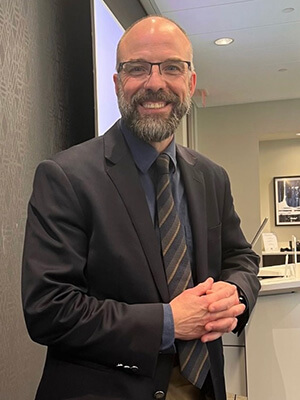
Security professionals working on risk assessment at meetings will look at “everything from a first-aid event … all the way to the very far end, which would be terrorism, potentially,: said John Gainer, vice president of security solutions provider TorchStone Global.
At Convening Leaders 2024, John Gainer — who served as an FBI special agent for more than 25 years and is currently vice president of security solutions provider TorchStone Global — will present the session, “Navigating the Unthinkable: A Holistic Approach to Mitigating Risk and Responding to Event Threats.”
Convene spoke with Gainer in late November to learn why thinking ahead about the unthinkable puts event organizers more, not less, at ease, and why they should put risk mitigation on the front burner. Here’s what he had to say:
On the importance of working with a security professional
Where I see things work really well is when event planners include a security professional from the start. Sometimes security is kind of put on a back burner or it’s assigned to a person who may not have the necessary experience to make sure that everything is being handled properly.
Security professionals will look at everything from a first-aid event — which is the most likely event, like somebody having a heart attack or some kind of medical emergency — all the way to the very far end, which would be terrorism, potentially.
It really starts with the threat and risk assessment to be conducted — that’s what a security professional is going to look at during early discussions and then go into the planning phase. Once that planning phase is accomplished, they can start to go into that security training phase, meaning that we’re getting things lined up so that people are prepared from a comprehensive perspective to have the right personnel in place to accomplish any type of task or any type of emergency event that comes up.

John Gainer’s session takes place Monday, Jan. 8 at CL24 in the San Diego Convention Center. For more about the program and to register, visit the Convening Leaders website.
Consider both external and internal disruptions
You must have a response plan that deals with both the external potentials and the internal potentials. A lot of people miss “protective intelligence” — that outward look where you have an intelligence analyst, a threat-management team that absorbs all that information that’s around the event, whether it’s a region or the city, and does an analysis of not just your event, but everything that’s been going on potentially the last six months or year prior to your event and having a really comprehensive understanding of what the potential risks are.
And then, once you have identified those potential risks, what are the types of groups or persons that could potentially carry out a type of disruptive event — some type of protest, someone hanging up a sign, someone putting powder up into the air or whatever it might be to garner attention and disrupt that event.
Recognize potential blind spots
A protective intelligence piece includes social-media monitoring. We know that a lot of disruptions to events [grow organically] from social media, so if you don’t have a piece in place that is monitoring the social-media activity around the city or the location, your convention center, and then particularly your event, you’re going to miss things. That is a particular vulnerability.
These things seem to happen very rapidly, but when you go back and look, you see that there was conversation [leading up to] this event on social media. When you have a protective intelligence analyst looking at that, they can start to put together pieces of the puzzle that can then get that information to your security professional who can let the event planners know what we’re seeing externally.
RELATED: Events and Venues Face New Challenges to Safety, Security
It really ties back to those original threat assessments when you assign a security professional who can build out, months in advance, this protective intelligence piece. For some large-scale events we work [on], we do a weekly report and we constantly update that intelligence piece — what are we seeing on social media? You can find what we call persons of interest — people who are particularly fixated on these events and [keynote speakers] and are seeking to garner attention.
Focus on your communication plan
A seasoned security professional has a relationship with the local law enforcement and eliminates the gap of getting information disseminated if something evolves at your event. The sooner you can get that municipality involved in your events, the sooner you can close that communication gap. What I see [in terms of the] most successful [events] is when we have a law enforcement professional liaison.
For communication on a tactical level, there are two aspects to that — at the venue itself and getting information out to attendees. Say if there’s a problem externally, like an active shooter in the area: What is the communication process to make sure that everybody has the information and that the best decisions can be made and communicated out? This comes down to defining roles ahead of time — who ultimately makes the call once that communication piece comes in, how it’s absorbed, how it’s disseminated within the venue team, within the event management team to make the right communication out to attendees who are either on their way to the event or at the event right now. If you have that set up in place ahead of time, then that communication flow is going to go a lot better.
Typically, the security professional is going to be the one who gets that piece of information and then gets it to the right person within the event management team and says, “This is what I recommend.” And then there’s a quick decision based on planning — and hopefully, tabletop training has been accomplished beforehand so that decision tree then just flows down where the event manager, the director, feels confident in turning over control to that security professional and saying, “Okay, I understand the recommendation. Let’s go with it.” That piece can be communicated out both internally from your organizing team and then externally to your venue attendees [through the event] app or you can have registrants opt in for text alerts.
RELATED: How to Plan for Possible Protesters at Your Event
This is a conversation that we have with a lot of different organizations as far as persons wanting to opt into their emergency management systems because people often feel like they’re being tracked. One of the methodologies that we think works really well is to communicate that this way: “We want to make sure that if there’s inclement weather, or other reasons for you to know you need to take any precautions, we can get this information to you.”
If you say we want your information because [we need to reach you] if there’s an active shooter or a terrorism event, that is going to make people very upset. It’s the same thing as flight attendants going through the emergency procedures in the unlikely event that there’s an emergency.
If we have this contingency in place, then we’re going to make this event much safer. When you communicate it that way, it lets attendees know that event organizers care about them, they want them to enjoy the event, and they want to see them get home to their loved ones.
Make time for scenario planning
Make sure that you’ve tested out your communications. Not all radios work in every spot or every venue. Sometimes you may have radio frequencies that work in certain areas and all of a sudden they don’t work in another area, depending on the size of the venue. And then there are redundancies within the technology itself — make sure cell service works and is tested ahead of time.
It’s critical to take the emergency plan beyond a couple pieces of paper and actually train on it. When you bring up the concept of training, I think a lot of people think, oh, it’s gotta be this big grand thing with people moving all over. But it can be accomplished via tabletop training. We can take the leadership and [key stakeholders] and walk through a couple scenarios — this is the lowest risk, this is our medium risk, this is our highest risk. Allow everybody to talk through it, with the understanding that this is a coaching event, not an “I gotcha” event, so that we can work through any issues that come up within that tabletop training.
Michelle Russell is editor in chief of Convene.
